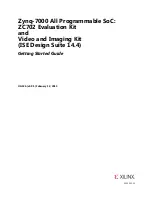
Understanding RAID Concepts and Levels
www.3ware.com
9
RAID 0
Provides striping, but no mirroring. Striped disk arrays achieve high transfer
rates because they can read and write data on more than one drive
simultaneously. The stripe size is configurable in the 3ware CLI, 3ware BIOS
Manager (3BM) and in the 3ware Disk Manager (3DM 2). Requires a
minimum of two drives.
When drives are configured in a striped disk array (see Figure 1), large files
are distributed across the multiple disks using RAID 0 techniques.
Striped disk arrays give exceptional performance, particularly for data
intensive applications such as video editing, computer aided design and
geographical information systems.
RAID 0 arrays are not fault tolerant. The loss of any drive results in the loss of
all the data in that array.
Figure 1. RAID 0 Configuration Example
RAID 1
Also known as a mirrored array. Mirroring is done on pairs of drives.
Mirrored disk arrays write data to two drives using RAID 1 algorithms (see
Figure 2). This gives your system fault tolerance by preserving the data on
one drive if the other drive fails. Fault tolerance is a basic requirement for
mission critical systems like web and database servers.
3ware uses a patented technology, TwinStor®, on RAID 1 arrays for
improved performance during sequential read operations. With TwinStor
technology, read performance is twice the speed of a single drive during
sequential read operation.
The adaptive algorithms in TwinStor technology boost performance by
distinguishing between random and sequential read requests. For the
sequential requests generated when accessing large files, both drives are used,
with the heads simultaneously reading alternating sections of the file. For the
smaller random transactions, the data is read from a single optimal drive head.














































